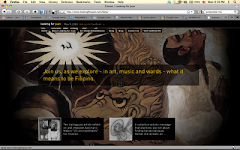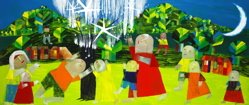In yet another demonstration of the beauty of the Internet, a few taps on my keyboard, and I found this online translator. Here's what CANVAS would look like in alibata:




I tried translating various words and found it quite fascinating. (It reminds me of the elven runes that Tolkien wrote about in Lord of the Rings.)
Try it out with your kids. It's a great way to get them introduced to or more interested in Philippine history and art.
==========================
Teaching ABCs the alibata way
by Tina Santos
Philippine Daily Inquirer. May 13, 2007
MANILA, Philippines – Raymond Cosare initially couldn't explain his fascination with the Chinese brush.
"I was just fond of collecting it but I didn't know why," he told the Inquirer.
A psychology professor at the Far Eastern University, the 38-year-old Cosare discovered the answer about seven years ago shortly after he began working as a volunteer at Bahay Nakpil-Bautista, an old house in Quiapo, Manila that has been turned into a museum for artifacts belonging to its previous owners and members of the Katipunan.
Since 2000, Cosare has been putting his brush collection to good use by teaching children, as well as the young at heart, the art of writing the baybayin, the ancient Filipino script.
He explained that baybayin is an old Tagalog word that refers to all the letters or alphabet used in writing a language. It is taken from the root word, baybáy, meaning "to spell."
Syllabic writing system
The baybayin is a syllabic writing system, which means that each letter represents a syllable instead of just a basic sound compared to the modern alphabet. There are a total of 17 characters: three vowels and 14 consonants, but when combined with the small vowel-modifying marks called kudlít, the number of characters increases to 45, Cosare
added.
"Though it is more commonly known as alibata, it is proper to use baybayin," he stressed.
He explained that alibata was the term introduced in the early 1900s by Paul Versoza of the University of Manila. He said Versoza claimed that the term was coined from alif, ba and ta, the first three letters of the Maguindanao arrangement of the Arabic letters.
These days, while his students are on their summer break, Cosare is busy holding "baybayin classes" for curious guests who drop by Bahay Nakpil-Bautista.
His students include children and their mothers as well as local and foreign tourists, he said.
Each class, which lasts about an hour and a half, begins with Cosare talking about the history of baybayin.
"It's very informal because I don't want them to get bored, especially if it's the kids I'm talking to," he added.
But the real magic begins as soon as Cosare's eager students sit on the wooden floor of the ancient house to write their names in baybayin using a brush, paper, ink or paint.
"They write awkwardly at first but little by little, they develop confidence until their handwriting flows, and the curls they draw become so natural it's as if they've known how to do this before," he said of his students.
According to Cosare, he first encountered baybayin when he was in second year high school.
"Our Filipino teacher wrote the baybayin characters on the blackboard but she did not explain it, she just told us to copy what she was writing on the board," he said. He added that he quickly became interested in learning how to write the characters, even using these
to write letters and journals.
"I mastered baybayin because I used it to hide my deepest thoughts in my journal—my way of protecting it from my nosy siblings," he said with a laugh. "At least, they wouldn't understand what these characters stood for."
But with no one to share his newfound interest with, Cosare put aside baybayin when he got to college.
Then one day, Teresita Obusan, the ebullient curator of Bahay Nakpil-Bautista, showed him material that featured seemingly intimidating characters.
"She asked me to practice writing it and use those characters in writing 'Merry Christmas' on cards she was about to send her friends. She was surprised because I finished faster than she thought I would. That's when I told her that I've been writing baybayin since high school," Cosare recalled.
Since then, Cosare said he and Obusan have found something new to share with guests of Bahay Nakpil-Bautista, apart from giving them a tour of the house and of Quiapo.
Asked why it was significant to study something that many people has long regarded as "useless" and passe, he answered: "Baybayin is something Filipinos can really call their own. So, why don't we use it?"
Making Filipinos prouder
"But more importantly, baybayin makes Filipino people prouder of who they are," he added.
Contrary to common belief, when the Spaniards arrived in the country, they found a culture that was very different from their own, he said.
"The ability to read and write is the mark of any civilization and according to many early Spanish accounts, our ancestors had already been writing with the baybayin for at least a century. This script was just beginning to spread throughout the islands at that time," Cosare
added.
But baybayin soon went out of style. "Perhaps practicality was the main reason," was his answer when asked why, adding that social expediency could be another.
He further explained: "Maybe Filipinos abandoned baybayin in favor of the alphabet because they found the latter easy to learn and it was a skill that helped them to get ahead in life under the Spanish regime, working in relatively prestigious jobs as clerks, scribes and
secretaries."
But Cosare happily noted that because of information revolution, many Filipinos are taking a new interest in their heritage and it is usually the baybayin that catches their attention first.
"Through the use of computer fonts, the baybayin is now being used in graphic designs for websites, multimedia art, jewelry, compact discs, T-shirts, and logos," he disclosed.
And for some Pinoys, it seems that baybayin has come full circle, he added. "Today, a growing number of young Filipinos are getting tattooed with baybayin characters to show their pride in their heritage."
However, he claimed that he was referring to Filipinos staying in other parts of the country.
"Malakas ang interest (There is a lot of interest). But for some, either they're not aware or they find it very Filipino. I don't know what that means but somehow too Filipino is not a very positive thing for others."
"Check the Internet and you will see that most websites about baybayin were done by Filipino-Americans, Filipino-Canadians, walang purong Pinoy," Cosare lamented.
According to him, he would be happy if baybayin is introduced in school curriculums.
"The suggestion has always been there but maybe the Department of Education has other concerns for now," he said, adding that it would be better to introduce baybayin to preschool children.
Ultimately, Cosare added, his goal is to be able to produce a book about baybayin.
"That's my next target. To reach out to more people, something that hopefully would give them a little pride, something that would work wonders for the Filipino people's sense of who they are," he added.





4 comments:
The Inquirer piece was indeed interesting but parts of it were plagiarized. See this letter to the editor:
http://opinion.inquirer.net/inquireropinion/letterstotheeditor/view_article.php?article_id=67901
Maybe this link will work better:
http://opinion.inquirer.net/inquireropinion/
letterstotheeditor/view_article.ph
Sorry to load up your comment box like this. The links don't work. Please google the name "Raymond Cosare" to see my letter to the Inquirer, "Missing attributions a disservice to scholarship."
Well I think that might be a bit true. Everyone has a bit of deep truth in them that isn't really visible at most times. But hey what can I say.. Do we Really want to know the absolute truth about Everyone?? Sometimes, the inner secrets of a person should remain unknown, of course if they harm no body. I do think that stories though, are entertaining whether they are positive or negative, because they depict a 'kodak moment' in time that tells a story. You're right, everybody loves a story or two, so why not imagine your life a big story and be a great story teller!
Xerox Ink
Post a Comment